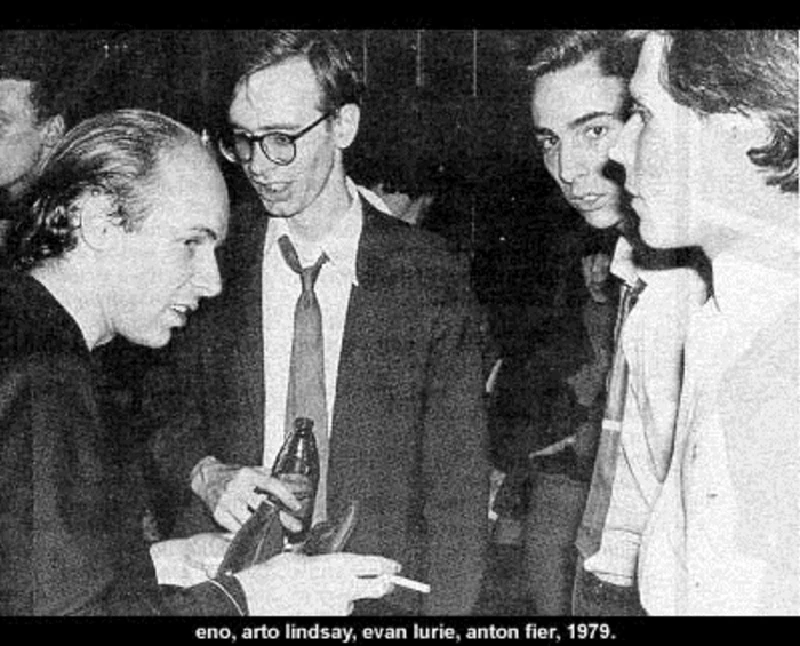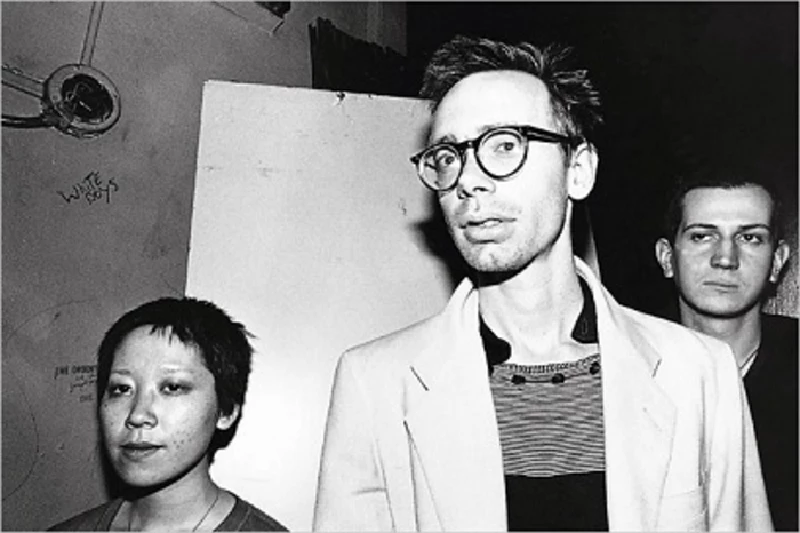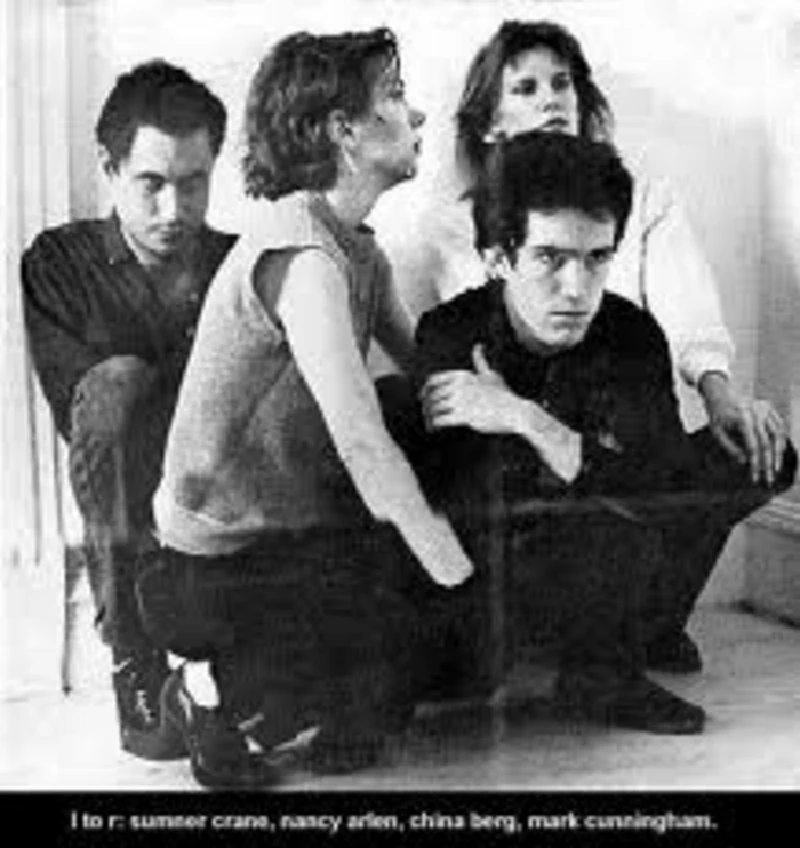Miscellaneous - No Wave Part 3
by Jon Rogers
published: 20 / 7 / 2011

intro
In the third part of his four part series, on New York's late 1970's confrontational No Wave movement, Jon Rogers reflects upon Brian Eno's album 'No New York', which featured four of its acts Teenage Jesus and the Jerks, James Chance and the Contortions, Mars and DNA.
One person who attended all five nights of the 1978 no wave festival was the former Roxy Music musician Brian Eno, who had come to New York to master the Talking Heads second album 'More Songs About Buildings and Food' and scout around for bands for his Obscure Records label. Eno dubbed this new crop of musicians as "research bands" in a 'Creem' interview in late 1978 as to his eyes they were experimental, avant-garde and uncompromising as well as eschewing the clichéd gestures of rock 'n' roll: "deliberately [taking] extreme stances that are very interesting because they define the edges of a piece of territory." While Eno's own music had little in common with the likes of DNA and Mars, Eno did see them as fellow travellers with him. "For the last four or five years, there has been a new wave," he later told the 'Melody Maker'. "At one time, it consisted of not too many people, of which I was one." Eno, having been tipped off by Anya Phillips and the 'New York Times' music critic John Rockwell, ventured down to the Artists Space to check out these new bands and was suitably impressed and hit upon the idea of having their material documented on a compilation, and acting as some sort of aural curator he would be the one to make it happen. With Eno's reputation as a seasoned and accredited tastemaker of vanguard music trends Island Records were actively interested in the project after just one phone call. With the label's involvement Big Apple, a cheap downtown studio, was booked and Eno mulled over who to include on the release. Eno's shortlist, according to Sheppard, consisted of ten bands, most of whom had just played the no wave festival although only four actually got the nod: Teenage Jesus and the Jerks, the Contortions, Mars and DNA. Those bands that Eno selected - and those he left out - caused friction amongst the scene. According to Sonic Youth's guitarist Lee Ranaldo, who would emerge from no wave, 'No New York' "created a heavy schism in the New York scene, because of who he chose and who he didn't." Some bands Eno considered only really had 15 seconds of fame, let alone their supposed 15 minutes. Groups such as Terminal and the Boris Police Band (whose 'vocals' were made from NYPD radio broadcasts) realistically stood little chance of inclusion and seemed destined for obscurity from the start. Others were more serious contenders like the Theoretical Girls, fronted by composer and guitarist Glenn Branca; the Gynaecologists, headed by Rudolph Grey, and Tone Death, lead by Rhys Chatham. These latter bands Eno, ultimately, considered too entwined with the SoHo art scene and too established. Effectively they were seen as not new, or indeed 'no', enough for inclusion. Bending Eno's ear were Lindsay and DNA keyboardist Robin Crutchfield who nudged Eno towards his final four selections - all of whom just happened to be friends and share the same rehearsal loft. Lindsay admitted in 'On Some Faraway Beach' that "We very deliberately kept the 'No New York' record to just those bands. We thought it would make sense and it was a little bit of a turf thing - we convinced Eno that Glenn Branca's band shouldn't be on the record." Branca wasn't happy about being left off and vocalised his disquiet - and he would later go on to critise Eno for making all the bands sound the same. But in the bands Eno had chosen he felt that he had assembled a representative cross-section of zeitgeist-defining artists. Each of the bands would be allocated four songs apiece with one day each set aside for recording. Eno took a very hands-off approach - although he did add echo to the guitar part's click and compression on Mars' track 'Helen Fordsdale' in an attempt to make it sound "like helicopter blades." According to Cunningham, Eno was very much "hands on" with his band: "We were actually more conservative than Eno, feeling that the music's radicalism didn't need to be saturated in special effects." Whereas in previous Eno-lead projects he had used the studio as a musical instrument now it was little more than a top-of-the-range Dictaphone. "We set up in such a way like we were doing a live gig," related Chance in 'Babylon's Burning'. "He [Eno] didn't even put me in a booth. Everything was leaking on to other tracks, and we just played the songs like we were doing a gig. Except for 'Can't Stand Myself'. That was kind of improvised in the studio. At the end I just wanted to redo a part of the vocals, but it was impossible. I guess he did that on purpose. it was more like an anti-production method." Lydia Lunch was sceptical of Eno's involvement and stated to the critic Lester Bangs her aversion to his music: "It's just something that flows and weaves, flows and weaves. It's kind of nauseating. It's like drinking a glass of water. It means nothing, but it's very smooth going down." Eno's hands-off approach in the studio irritated Lunch who spotted Eno whilst her band was recording on the other side of the control room glass nonchalantly reading 'The New York Times'. There was method to Eno's apparent production madness as he later told Bangs that he had deliberately done a muddy mix of the bands as a way of hopefully capturing some of the "lazy kineticism of The Velvet Underground." But he'd also managed to capture their "raw, feral intensity". And Island weren't happy either when they received the master tapes in late May. According to Sheppard, Island's A&R staff were "aghast" at the results and had favoured a little more of Eno's "water" rather than an aural version of strychnine. Part of the problem was Island itself. Despite having a strong and credible reputation in the music industry the label saw its 'core business' as the developing reggae market and effectively ignored punk altogether. The synth-drenched Ultravox! and the energetic pub R&B of Eddie and the Hot Rods was about as close as the label came to punk's aggression. It wasn't interested in dissonance. With Eno's track record the label was expecting something arty and left-field but also accessible, perhaps something along the lines of Talking Heads. It wasn't prepared for several variations of atonal noise, grating dissonance, jarring discord and plenty of existential angst, never mind anything resembling a tune that was hummable. There was talk amongst the record executives about dropping the album that Eno had called 'No New York' entirely but by then the involvement of Eno as well as the downtown grapevine had meant that the release was greatly anticipated. In the end the album was released towards the end of summer 1978 and slipped out on Island's ancillary label Antilles (which was also home to Eno's Obscure label releases in the USA). In a strange move all the lyrics were printed on the inside of the record sleeve, a move that meant that if a listener wanted to read them they would have to rip apart the packaging. Perhaps due to a mixture of the relatively obscure bands to anyone outside of New York and Island's distancing themselves from the whole thing it's not surprising that the album failed to make it into the Billboard 100. Critics seemed to be baffled by the whole thing, if acknowledging the bravery of undertaking such an album. Tom Carson in 'Rolling Stone' wrote: "While Eno initiated the current project, he doesn't seem to have put much energy into it: his production is unusually restrained. On the whole, he appears more taken with the basic idea rather than the actual substance of the music, and such priorities seem perfectly appropriate." Carson wasn't impressed: "Despite its intellectual top-heaviness, the music on 'No New York' is all surface: militantly anti-melodic, inaccessible and anti-humanist. The fact that nihilism is here reduced to an aesthetic pose only makes the message even more wilfully repellent." Richard C. Walls wrote in ‘Creem’ that it was the most: "ferociously avant-garde and aggressively ugly music since Albert Ayler puked all over my brain back in - what? - '64." While Glenn Branca was part of the new downtown scene he was still removed slightly from the centre of the action. To bands like DNA and Mars, Branca was very much part of the 'art' scene and not the 'rock' one. In 'Confusion is Next' Branca states: "They thought we were the SoHo bands. That we were, to be very explicit, 'art fags'. They really thought that we were not part of what they considered to be their scene. And they obviously convinced Eno of that." Effectively 'No New York' by including DNA, the Contortions, Mars and Teenage Jesus and the Jerks, geographically located no wave in the East Village. Bands like the Gynaecologists, led by the music director of the Kitchen and composer Rhys Chatham, and Red Transistor, as well as the Theoretical Girls were seen as part of the SoHo camp causing a split in the ranks. Those bands started boycotting the downtown rock clubs as a protest as what they saw as unfair booking and paying policies and playing gigs in performance spaces and lofts like Rhys Chatham's centre for video and music.
Picture Gallery:-


most viewed articles
current edition
Carl Ewens - David Bowie 1964 to 1982 On Track: Every Album, Every SongEditorial - July 2025
Billie Eilish - O2 Arena, London, 10/7/2025
Bathers - Photoscapes 2
Bathers - Photoscapes 1
Hothouse Flowers - Photoscapes
John McKay - Interview
Cleo Laine - 1927-2025
Simian Life - Interview
the black watch - Interview
previous editions
Heavenly - P.U.N.K. Girl EPTrudie Myerscough-Harris - Interview
Pixies - Ten Songs That Made Me Love...
Boomtown Rats - Ten Songs That Made Me Love....
Fall - Hex Enduction Hour
Peter Paul and Mary - Interview with Peter Yarrow
Sam Brown - Interview Part 2
And Also The Trees - Eventim Apollo, London, 21/12/2014.
Doris Brendel - Interview
Place to Bury Strangers - Interview
most viewed reviews
current edition
Sick Man of Europe - The Sick Man of EuropeAmy Macdonald - Is This What You've Been Waiting For?
Phew, Erika Kobayashi,, Dieter Moebius - Radium Girls
Alice Cooper - The Revenge of Alice Cooper
Blueboy - 2
Lucy Spraggan - Other Sides of the Moon
Cynthia Erivo - I Forgive You
Bush - I Beat Loneliness
Davey Woodward - Mumbo in the Jumbo
Philip Jeays - Victoria
Pennyblackmusic Regular Contributors
Adrian Janes
Amanda J. Window
Andrew Twambley
Anthony Dhanendran
Benjamin Howarth
Cila Warncke
Daniel Cressey
Darren Aston
Dastardly
Dave Goodwin
Denzil Watson
Dominic B. Simpson
Eoghan Lyng
Fiona Hutchings
Harry Sherriff
Helen Tipping
Jamie Rowland
John Clarkson
Julie Cruickshank
Kimberly Bright
Lisa Torem
Maarten Schiethart